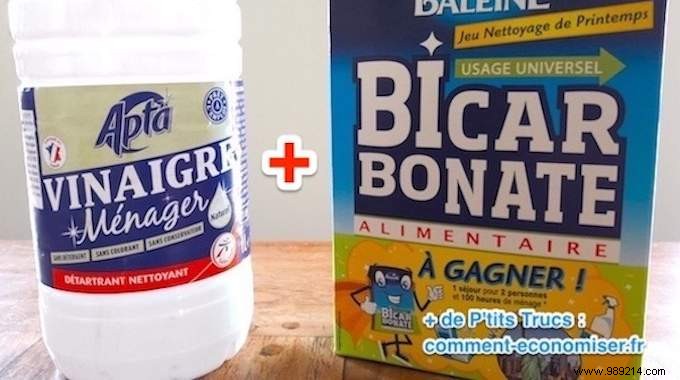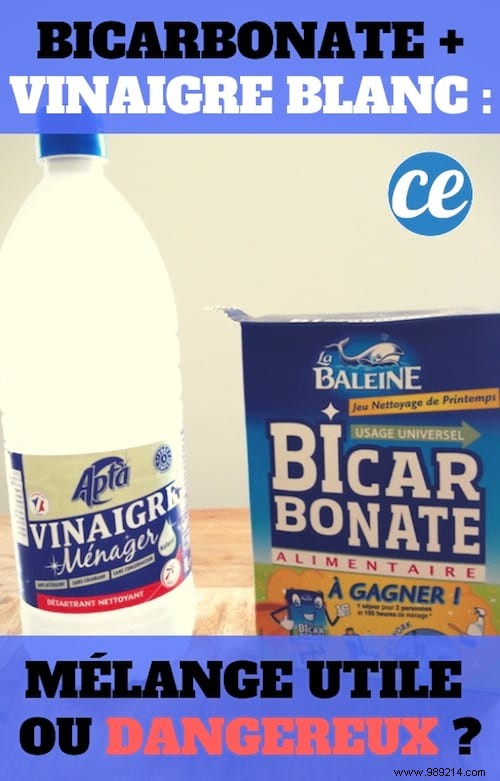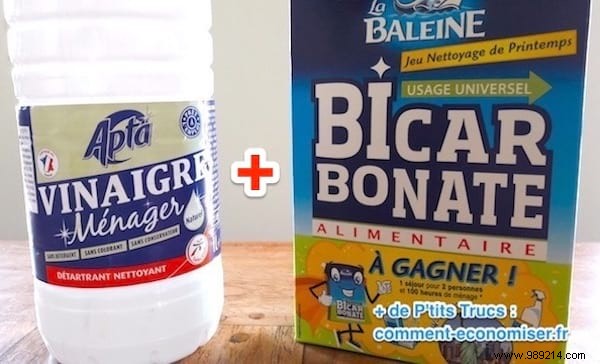
Is it safe to mix baking soda and white vinegar?
Good question ! And many of you ask us!
It is true that recipes for household products that combine these 2 products are common.
But is it really a good idea?
Indeed, what happens if you mix baking soda and vinegar which contains acetic acid?
Together we will try to see a little more clearly about the chemical reaction of baking soda and vinegar. Explanations:

When you mix baking soda and white vinegar, the mixture starts to foam.
In chemistry, this reaction can be transcribed by the following equation:NaHCO3 (aq) + CH3 COOH (aq) —> CO2 (g) + H2O (l) + CH3 COONa (aq)
If, like me, you forgot everything about your chemistry lessons, the equation can be translated as follows:
Sodium bicarbonate + Acetic acid =
Carbon Dioxide + Water + Sodium Acetate
Those little bubbles you see when you mix vinegar and baking soda are carbon dioxide (or CO2).
Carbon dioxide is not dangerous since it is naturally present in the air.
The other substance that also forms is water. Obviously, this does not represent any risk.
On the other hand, sodium acetate is also formed.
What do we know about this chemical compound? Is it dangerous?
Fortunately, sodium acetate is just as harmless as baking soda and white vinegar!
It should still be noted that it is irritating if you put a lot on the skin.
And you also have to avoid getting it in your eyes, because it stings as much as vinegar...

The reaction between baking soda and vinegar is a so-called "acid/base reaction".
Be aware that if you mix baking soda and white vinegar in the right quantities, all of the baking soda will react.
Take a vinegar with 8% acidity:this means that there are 80 g of natural acetic acid per liter of vinegar.
For there to be a complete reaction, it all depends on the dosage. Mix 45 ml of vinegar (about 1/3 glass) with 5 g of baking soda (a teaspoon).
If there is more bicarbonate, some will remain at the end of the reaction. And if you add more vinegar, then there will be vinegar left.
On the other hand, if you make the right mixture, nothing will remain, except only water and acetate.
Many recipes recommend mixing vinegar and baking soda for house cleaning, laundry, mopping floors or descaling...
But is it a good idea since the 2 mixed products neutralize each other?
It all really depends on the acetate and its properties created during this reaction.
There is no real proof of the cleaning, degreasing or descaling effectiveness of acetate.
On the other hand, there are many testimonials attesting to the effectiveness of the baking soda + vinegar duo in water.
So should we believe that this effectiveness is due to a bad dosage of the baking soda and white vinegar mixture?
It's possible ! If there is some baking soda left, this may have an advantage, as baking soda is mildly abrasive.
And if there is some white vinegar left, it may be of interest, because vinegar is acidic.
Surprising, isn't it?
Even if we can doubt the effectiveness of acetate...
...what is certain is that the vinegar + baking soda mixture creates an effervescence that is very useful for cleaning.
Indeed, this mechanical efficiency is very practical in several cases, in particular for:
- Unclog the sink or toilet pipes. Find out how here.
- Clean greasy or burnt surfaces. Find out how here.
- Whiten the tile joints. Find out how here.
- Descale the toilet bowl. Discover the trick here.